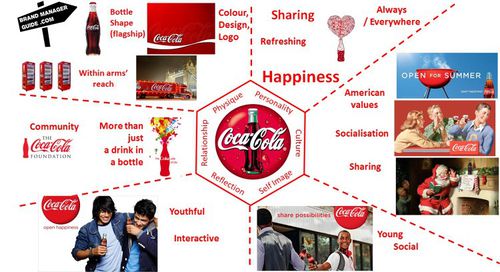Brand Identity Prism
The Brand Identity Prism is a concept coined by J. Kapferer in 1986. According to him, any brand can be identified by its characteristics. The Brand Prism is represented by a hexagonal prism which defines 6 characters of a brand. Just like a person is known by his name, job, education, physical and emotional traits, a brand can be identified by the following:-
- Physical Facet:- Salient physical qualities which are seen by the target audienc - like its color, shape, logo or anything that brings an image in the mind of the consumer when thinking or talking about the brand.
- Brand Personality:- This defines the brand's personality or character. Here the brand is personified and its traits are perceived in the eyes of the consumer in a particular way. It can be related to calling a person shy or stylish or philanthropic.
- Brand Culture:- This represents the values and principles a brand stand for. For example, a brand that has a 'Go Green' motto will be eco friendly is all its aspects- from manufacturing to marketing.
- Brand Relationships:- The relationship a brand has, with its customers, the way each communication relates to its target audience or how brands influence and provide a particular service to its customers.
- Customer Reflection:- How a customer reflects with a particular brand. This is different with how customers perceive the brand. This talks more about the consumers who use the brand as opposed to the brand itself.
- Customer Self Image:- This explains how a customer perceives himself by using the brand. For example:- how men and women differentiate certain brands as being masculine or feminine.[1]

Figure 1. source: Zeynep Çıkın
Essentially, the prism has the style and themes of the marketer (sender) on one side which are being received by the consumer (recipient) on the other side. The other axes of the prism define the level of internalization or externalization of the activities. When flipped over, the brand identity prism is an integral part of the brand identity pyramid – which has 3 parts – (i) The Brand Kernel which is the ultimate essence or core of the brand (ii) The brand style – Which brings about the brand personality from the essence and (iii) Brand themes – or executions of the styles. While more elaborate tools (eg. brand keys) are being put to use today, this is still a favorite (especially when we need to quickly understand a new brand or a competitor). For any brand to succeed, it needs to present a coherent image in the minds of the consumer. All the 6 facets of the brand need to tie in with the central brand essence. As soon as all the elements come into place, it just clicks ! Lets take the example of Marlboro – developed as a ladies brand (in 1924, with “Mild as may” !!! as the tagline), and later re-positioned in 1954 using a ‘mythical cowboy’ – The new campaign raised sales by 3241 % within the year !!. Many other similar masculine platforms were tried, later returning to the cowboy theme – lasting till today and becoming one of the most quoted examples in Positioning. Here in lies the power of brand coherence or a consistent positioning of all these elements. Here’s the Coca Cola example ( see Figure 2. below) of how multiple facets come together in the prism – all to deliver happiness to the consumer making him feel a strong bond with the bottle.[2]

Figure 2. source: Brand Manager Guide
See Also
References
- ↑ What is Brand Identity Prism Gaebler
- ↑ The Brand Prism as part of brand identity BrandManagerGuide
Further Reading
- Using the Brand Identity Prism to Improve Your Marketing - A presentation Cate Costa
- Kapferer's Brand Identity Prism - An Overview OpenDrive.com
